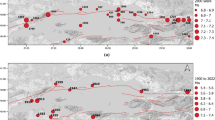Abstract
This paper presents a random physical model of seismic ground motion field on a specific local engineering site. With this model, artificial ground motions which are consistent with realistic records at SMART-1 array on spatial correlation are synthesized. A two-scale modeling method of seismic random field is proposed. In large scale, the seismic ground motion field on bedrock surface is simplified to a two-dimensional spherical wave field based on the seismic point source and homogeneous isotropic media model. In small scale, the seismic ground motion field on the engineering site has a plane waveform. By introducing the physical models of seismic source, path and local site and considering the randomness of the basic physical parameters, the random model of seismic ground motion field is completed in a random functional form. This model is applied to simulation of the acceleration records at SMART-1 array by using the superposition method of wave group.
Similar content being viewed by others
References
Zerva A, Zerva V. Spatial variation of seismic ground motions: An overview. Appl Mech Rev, 2002, 55: 271–297
Zerva A. Spatial Variation of Seismic Ground Motions: Modeling and Engineering Applications. New York: CRC Press, 2009. 65–127
Kanai K. Semi-empirical formula for the seismic characteristics of the ground. Bull Earthquake Res Inst, 1957, 35: 309–325
Kanai K. An empirical formula for the spectrum of strong earthquake motions. Bull Earthquake Res Inst, 1961, 39: 85–95
Clough R, Penzien J. Dynamic of Structures. New York: McGraw-Hill, Inc., 1975
Luco J E, Wong H L. Response of a rigid fiundtion to a spatially random ground motion. Earthquake Eng Struct Dyn, 1986, 14: 891–906
Harichandran R S, Vanmarcke E H. Stochastic variation of earthquake ground motion in space and time. J Eng Mech, 1986, 112: 154–174
Loh C H, Lin S G. Directionality and simulation in spatial variation of seismic waves. Eng Struct, 1990, 12: 134–143
Qu T J, Wang J J, Wang Q X. A practical model for the power spectrum of spatially variant ground motion. Acta Seismologica Sinica, 1996, 9(1): 69–79
Li J. Physical stochastic models for the dynamic excitations of engineering structures. In: Li J, Chen J B, eds. Advances in Theory and Applications of Random Vibration (in Chinese). Shanghai: Tongji University Press, 2008. 119–132
Shinozuka M. Simulation of multivariate and multidimensional random processes. J Acoustical Society Am, 1971, 49: 357–367
Shinozuka M. Stochastic fields and their digital simulation. In: Schuëller G I, Shinozuka M, eds. Stochastic Methods in Structural Dynamics. Dordrecht: Martinus Nijhoff Publishers, 1987. 93–133
Shinozuka M, Deodatis G, Zhang R, et al. Modeling, synthetics and engineering applications of strong earthquake wave motion. Soil Dyn Earthquake Eng, 1999, 18: 209–228
Li J, Ai X Q. Study on random model of earthquake ground motion based on physical process (in Chinese). Earthquake Eng Engng Vib, 2006, 26(5): 21–26
An Z H, Li J. Research on random function model of strong ground motion (I): Model constructing (in Chinese). Earthquake Eng Engng Vib, 2009, 29(5): 36–45
Wang D, Li J. Physical random function model of ground motions for engineering purposes. Sci China Tech Sci, 2011, 54: 175–182
Aki K, Richards P G. Quantitative Seismology Theory and Methods. San Francisco: W. H. Freeman and Company, 1980. 9–35
Haskell N A. Total energy and energy spectral density of elastic wave radiation from propagating faults. Part II. A statistical source model. Bull Seismological Society Am, 1966, 56: 125–140
Aki K. Scaling law of seismic spectrum. J Geophys Res, 1967, 72(4): 1217–1231
Shearer P M. Introduction to Seismology. 2nd Ed. New York: Cambridge University Press, 2009. 251–255
Penzien J, Watabe M. Characteristics of 3-dimensional earthquake ground motions. Earthquake Eng Struct Dyn, 1974, 3(4): 365–373
Kubo T, Penzien J. Analysis of three-dimensional strong ground motions along principal axes, San Fernando earthquake. Earthquake Eng Struct Dyn, 1979, 7(3): 265–278
Liao Z P. Introduction to Wave Motion Theories for Engineering (in Chinese). Beijing: Science Press, 2002. 16–25
Boore D M. Simulation of ground motion using the stochastic method. Pure Appl Geophys, 2003, 160: 635–676
Brune J N. Tectonic stress and the spectra of seismic shear waves from earthquake. J Geophys Res, 1970, 75: 4997–5009
Boissières H, Vanmarcke E H. Estimation of lags for a seismograph array: Wave propagation and composite correlation. Soil Dyn Earthquake Eng, 1995, 14: 5–22
Loh C H. Analysis of the spatial variation of seismic waves and ground movements from SMART-1 data. Earthquake Eng Struct Dyn, 1985, 13: 561–581
Li J. A physical approach to stochastic dynamical systems (in Chinese). Sciencepaper Online, 2006, 1(2): 95–104
Author information
Authors and Affiliations
Corresponding author
Rights and permissions
About this article
Cite this article
Wang, D., Li, J. A random physical model of seismic ground motion field on local engineering site. Sci. China Technol. Sci. 55, 2057–2065 (2012). https://doi.org/10.1007/s11431-012-4850-5
Received:
Accepted:
Published:
Issue Date:
DOI: https://doi.org/10.1007/s11431-012-4850-5




